+ Open data
Open data
- Basic information
Basic information
| Entry | Database: PDB / ID: 5aby | |||||||||
|---|---|---|---|---|---|---|---|---|---|---|
| Title | Complex of C. elegans eIF4E-3 with the 4E-binding protein Mextli | |||||||||
 Components Components |
| |||||||||
 Keywords Keywords | TRANSLATION / GENE REGULATION / CAP BINDING PROTEIN / 4E BINDING PROTEIN | |||||||||
| Function / homology |  Function and homology information Function and homology informationtranslation initiation complex / Activation of the mRNA upon binding of the cap-binding complex and eIFs, and subsequent binding to 43S / regulation of formation of translation initiation ternary complex / ISG15 antiviral mechanism / L13a-mediated translational silencing of Ceruloplasmin expression / Translation initiation complex formation / Ribosomal scanning and start codon recognition / 21U-RNA metabolic process / RNA cap binding complex / piRNA processing ...translation initiation complex / Activation of the mRNA upon binding of the cap-binding complex and eIFs, and subsequent binding to 43S / regulation of formation of translation initiation ternary complex / ISG15 antiviral mechanism / L13a-mediated translational silencing of Ceruloplasmin expression / Translation initiation complex formation / Ribosomal scanning and start codon recognition / 21U-RNA metabolic process / RNA cap binding complex / piRNA processing / eukaryotic initiation factor 4E binding / eukaryotic translation initiation factor 4F complex / RNA 7-methylguanosine cap binding / embryo development ending in birth or egg hatching / translation initiation factor activity / positive regulation of translation / translational initiation / regulation of translation / perinuclear region of cytoplasm / RNA binding / cytoplasm Similarity search - Function | |||||||||
| Biological species |  | |||||||||
| Method |  X-RAY DIFFRACTION / X-RAY DIFFRACTION /  SYNCHROTRON / SYNCHROTRON /  MOLECULAR REPLACEMENT / Resolution: 1.95 Å MOLECULAR REPLACEMENT / Resolution: 1.95 Å | |||||||||
 Authors Authors | Peter, D. / Weichenrieder, O. | |||||||||
 Citation Citation |  Journal: Genes Dev. / Year: 2015 Journal: Genes Dev. / Year: 2015Title: Mextli Proteins Use Both Canonical Bipartite and Novel Tripartite Binding Modes to Form Eif4E Complexes that Display Differential Sensitivity to 4E-BP Regulation Authors: Peter, D. / Weber, R. / Koene, C. / Chung, M.-Y. / Ebertsch, L. / Truffault, V. / Weichenrieder, O. / Igreja, C. / Izaurralde, E. | |||||||||
| History |
| |||||||||
| Remark 650 | HELIX DETERMINATION METHOD: AUTHOR PROVIDED. |
- Structure visualization
Structure visualization
| Structure viewer | Molecule:  Molmil Molmil Jmol/JSmol Jmol/JSmol |
|---|
- Downloads & links
Downloads & links
- Download
Download
| PDBx/mmCIF format |  5aby.cif.gz 5aby.cif.gz | 271.4 KB | Display |  PDBx/mmCIF format PDBx/mmCIF format |
|---|---|---|---|---|
| PDB format |  pdb5aby.ent.gz pdb5aby.ent.gz | 224.5 KB | Display |  PDB format PDB format |
| PDBx/mmJSON format |  5aby.json.gz 5aby.json.gz | Tree view |  PDBx/mmJSON format PDBx/mmJSON format | |
| Others |  Other downloads Other downloads |
-Validation report
| Summary document |  5aby_validation.pdf.gz 5aby_validation.pdf.gz | 474.1 KB | Display |  wwPDB validaton report wwPDB validaton report |
|---|---|---|---|---|
| Full document |  5aby_full_validation.pdf.gz 5aby_full_validation.pdf.gz | 475.6 KB | Display | |
| Data in XML |  5aby_validation.xml.gz 5aby_validation.xml.gz | 28.8 KB | Display | |
| Data in CIF |  5aby_validation.cif.gz 5aby_validation.cif.gz | 42.1 KB | Display | |
| Arichive directory |  https://data.pdbj.org/pub/pdb/validation_reports/ab/5aby https://data.pdbj.org/pub/pdb/validation_reports/ab/5aby ftp://data.pdbj.org/pub/pdb/validation_reports/ab/5aby ftp://data.pdbj.org/pub/pdb/validation_reports/ab/5aby | HTTPS FTP |
-Related structure data
| Related structure data |  5abuC  5abvC 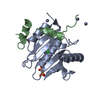 5abxSC C: citing same article ( S: Starting model for refinement |
|---|---|
| Similar structure data |
- Links
Links
- Assembly
Assembly
| Deposited unit | 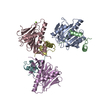
| ||||||||
|---|---|---|---|---|---|---|---|---|---|
| 1 | 
| ||||||||
| 2 | 
| ||||||||
| 3 | 
| ||||||||
| Unit cell |
| ||||||||
| Components on special symmetry positions |
|
- Components
Components
| #1: Protein | Mass: 22377.488 Da / Num. of mol.: 3 / Fragment: UNP RESIDUES 30-215 Source method: isolated from a genetically manipulated source Source: (gene. exp.)   #2: Protein/peptide | Mass: 4740.511 Da / Num. of mol.: 3 / Fragment: UNP RESIDUES 471-507 Source method: isolated from a genetically manipulated source Source: (gene. exp.)   #3: Chemical | #4: Chemical | #5: Water | ChemComp-HOH / | Sequence details | THE FIRST FOUR RESIDUES OF CHAINS A, C, E REMAIN FROM THE EXPRESSION TAG. THE FIRST FOUR RESIDUES ...THE FIRST FOUR RESIDUES OF CHAINS A, C, E REMAIN FROM THE EXPRESSION | |
|---|
-Experimental details
-Experiment
| Experiment | Method:  X-RAY DIFFRACTION / Number of used crystals: 1 X-RAY DIFFRACTION / Number of used crystals: 1 |
|---|
- Sample preparation
Sample preparation
| Crystal | Density Matthews: 2.67 Å3/Da / Density % sol: 54 % / Description: NONE |
|---|---|
| Crystal grow | pH: 8 / Details: 0.1M TRIS, PH=8.0, 0.2M MGCL2, 17% PEG6000 |
-Data collection
| Diffraction | Mean temperature: 100 K |
|---|---|
| Diffraction source | Source:  SYNCHROTRON / Site: SYNCHROTRON / Site:  SLS SLS  / Beamline: X10SA / Wavelength: 1.00001 / Beamline: X10SA / Wavelength: 1.00001 |
| Detector | Type: DECTRIS PILATUS 6M / Detector: PIXEL / Date: May 27, 2015 / Details: DYNAMICALLY BENDABLE MIRRORS |
| Radiation | Monochromator: SI(111) / Protocol: SINGLE WAVELENGTH / Monochromatic (M) / Laue (L): M / Scattering type: x-ray |
| Radiation wavelength | Wavelength: 1.00001 Å / Relative weight: 1 |
| Reflection | Resolution: 1.95→47.2 Å / Num. obs: 58918 / % possible obs: 100 % / Observed criterion σ(I): -3 / Redundancy: 8.3 % / Biso Wilson estimate: 29.49 Å2 / Rsym value: 0.12 / Net I/σ(I): 11.8 |
| Reflection shell | Resolution: 1.95→2 Å / Redundancy: 8.6 % / Mean I/σ(I) obs: 2 / Rsym value: 1.17 / % possible all: 100 |
- Processing
Processing
| Software |
| ||||||||||||||||||||||||||||||||||||||||||||||||||||||||||||||||||||||||||||||||||||||||||||||||||||||||||||||||||||||||||||||||||||||||||||||||||||||||||
|---|---|---|---|---|---|---|---|---|---|---|---|---|---|---|---|---|---|---|---|---|---|---|---|---|---|---|---|---|---|---|---|---|---|---|---|---|---|---|---|---|---|---|---|---|---|---|---|---|---|---|---|---|---|---|---|---|---|---|---|---|---|---|---|---|---|---|---|---|---|---|---|---|---|---|---|---|---|---|---|---|---|---|---|---|---|---|---|---|---|---|---|---|---|---|---|---|---|---|---|---|---|---|---|---|---|---|---|---|---|---|---|---|---|---|---|---|---|---|---|---|---|---|---|---|---|---|---|---|---|---|---|---|---|---|---|---|---|---|---|---|---|---|---|---|---|---|---|---|---|---|---|---|---|---|---|
| Refinement | Method to determine structure:  MOLECULAR REPLACEMENT MOLECULAR REPLACEMENTStarting model: PDB ENTRY 5ABX Resolution: 1.95→45.522 Å / SU ML: 0.2 / σ(F): 1.36 / Phase error: 20.91 / Stereochemistry target values: ML Details: HYDROGENS WERE REFINED IN THE RIDING POSITIONS. THE FOLLOWING RESIDUES ARE DISORDERED. CHAIN A, RESIDUES 203 TO 209. CHAIN C, RESIDUES 203 TO 208. CHAIN E, RESIDUES 202 TO 209. CHAIN F, RESIDUE 507.
| ||||||||||||||||||||||||||||||||||||||||||||||||||||||||||||||||||||||||||||||||||||||||||||||||||||||||||||||||||||||||||||||||||||||||||||||||||||||||||
| Solvent computation | Shrinkage radii: 0.9 Å / VDW probe radii: 1.11 Å / Solvent model: FLAT BULK SOLVENT MODEL | ||||||||||||||||||||||||||||||||||||||||||||||||||||||||||||||||||||||||||||||||||||||||||||||||||||||||||||||||||||||||||||||||||||||||||||||||||||||||||
| Displacement parameters | Biso mean: 34.1 Å2 | ||||||||||||||||||||||||||||||||||||||||||||||||||||||||||||||||||||||||||||||||||||||||||||||||||||||||||||||||||||||||||||||||||||||||||||||||||||||||||
| Refinement step | Cycle: LAST / Resolution: 1.95→45.522 Å
| ||||||||||||||||||||||||||||||||||||||||||||||||||||||||||||||||||||||||||||||||||||||||||||||||||||||||||||||||||||||||||||||||||||||||||||||||||||||||||
| Refine LS restraints |
| ||||||||||||||||||||||||||||||||||||||||||||||||||||||||||||||||||||||||||||||||||||||||||||||||||||||||||||||||||||||||||||||||||||||||||||||||||||||||||
| LS refinement shell |
|
 Movie
Movie Controller
Controller




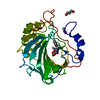
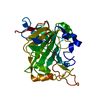
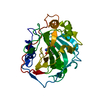

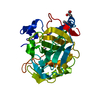

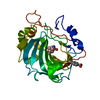
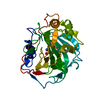
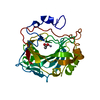
 PDBj
PDBj






